#Esher Surrey
Explore tagged Tumblr posts
Text

Wayneflete Tower,
Esher, Borough of Elmbridge, Surrey, United Kingdom
#art#design#architecture#history#luxury lifestyle#style#luxury house#luxury home#tower#wayneflete tower#united kingdom#surrey#esher#elmbridge#mole river#landscaping#castle
254 notes
·
View notes
Text
Discover Stylish Window Shutters in Surrey
Window shutter specialists are at your service! Choose from a variety of materials, styles, and finishes to create the perfect look for your windows. Enhance your privacy and add elegance to your home with our window shutters in Surrey.
You can opt for our services anywhere in Chessington, Kingston, Twickenham, Leatherhead, Surbiton, Guildford, Farnham, Esher, Epsom, New Malden, Worcester Park, Teddington and across Surrey and South West London.
#window shutters surrey#window shutters#Chessington#Kingston#Twickenham#Leatherhead#Surbiton#Guildford#Farnham#Esher#Epsom#New Malden#Worcester Park#Teddington#Surrey#South West London#United Kingdom
0 notes
Text
Greens, residents and LibDems put squeeze on Tory Surrey
Follow the yellow brick road: political editor WALTER CRONXITE takes a flight of fancy over the new political map of south-east England after last week’s local elections, which have given the LibDems much encouragement Pathway to success?: the LibDems are targeting Tory ministers’ seats in Surrey after last week’s results The fields of Surrey, Sussex and Kent are awash in vibrant green and yellow…

View On WordPress
#Chaldon#Conservative#Coulsdon#Council Tax#Croydon#Dominic Raab#Esher and Walton#Green Party#Jeremy Hunt#Labour#Liberal Democrats#Local elections 2023#Mario Creatura#Michael Gove#Reigate and Banstead#Sarah Jones MP#Shasha Khan#Slough Borough Council#South West Surrey#Surrey Heath#Tandridge#Tandridge District Council#Thurrock Council#Tory
0 notes
Text


Suki Potier, Brian Jones, and George Harrison at his home in Esher, Surrey, 1968. Photos were taken by George himself.
#suki potier#brian jones#george harrison#the rolling stones#the beatles#60s#1968#with the stones#swinging sixties#vintage
159 notes
·
View notes
Text
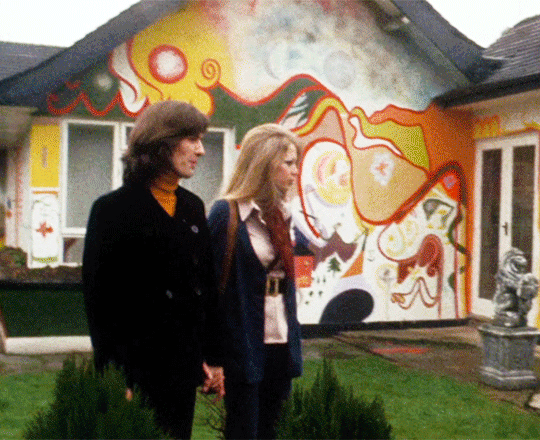

GEORGE HARRISON and PATTIE BOYD leave Kinfauns to go to the Walton and Esher Magistrates Court, March 18, 1969.
She was at Kinfauns, their bungalow home in Esher, Surrey, playing genial hostess to a group of visitors from Scotland Yard’s drug squad. She recalled the events in her memoir Wonderful Tonight: ‘Suddenly I heard a lot of cars on the gravel in the drive – far too many for it to be just George. My first thought was that maybe Paul and Linda wanted to party after the wedding. Then the bell rang. I opened the door to find a policewoman and a dog standing outside. At that moment the back-doorbell rang and I thought, Oh, my God, this is so scary! I’m surrounded by police.
The man in charge introduced himself as Detective Sergeant Pilcher, from Scotland Yard, and handed me a piece of paper. I knew why he was there: he thought we had drugs, and he said he was going to search the house. In they came, about eight policemen through the front, another five or six through the back and there were more in the greenhouse. The policewoman said she would follow me while the others searched and didn’t let me out of her sight. I said, ‘Why are you doing this? We don’t have any drugs. I’m going to phone my husband.’ I rang George at Apple. ‘George, it’s your worst nightmare. Come home.’
The officers clearly thought the Harrisons would be at Paul’s wedding. The timing was not a coincidence. (...) Pilcher had already busted Mick Jagger, Brian Jones and Donovan, as well as Lennon and Yoko the previous year. National treasures or not, The Beatles were no longer protected from the law. - ‘And in the End: The Last Days of The Beatles’ Ken McNab
I was with George in the office when that call came through. It was the end of a long day at Apple. Pattie rang and said, ‘They’re here – the law is here,’ and we knew what to do by then. We phoned Release’s lawyer, Martin Polden. We had a routine: he came round to Apple, and we all went down by limousine to Esher, where the police were well ensconced by then – and I stood bail for George and Pattie. They went off to the police station. We were all extremely indignant because it was the day of Paul’s wedding, a poor way to celebrate it. The police can be so nice.
George was calm about it. George is always calm – he sometimes gets a grump, but he’s always calm – and he was extremely calm that night, and very, very indignant. He went into the house and looked around at all these men and one woman, and said something like. ‘Birds have nests and animals have holes, but man has nowhere to lay his head.’ – ‘Oh, really, sir? Sorry to tell you we have to…’ and then into the police routine.
That’s how calm and how cross he was, because, as he said, he kept his dope in the box where dope went, and his joss sticks went in the joss stick box. He was a man who ran an orderly late-Sixties household, with beautiful things and some nice stuff to smoke.
In my opinion he didn’t have to be busted because he was doing nobody any harm. I still believe what they did was an intrusion into personal life. - Derek Taylor in ‘The Beatles Anthology’
#i think pete shotton's recollection of that event involved george chasing one of the photographers#through his garden with police running after them and the whole thing looked like a slapstick comedy#and i believe it did in fact look like that#mustard yellow turtleneck jumper you know it's serious#they look so good#pattie boyd#george harrison#the beatles#beatlesedit#thebeatlesedit
510 notes
·
View notes
Note
"many people insist he was in the Blitz ( I don't mean fics, I don't mind that, I mean in canon discussions) so my post was specifically for the Blitz. For the 40's bomb, that you brought up, not my post, Tom left soon after, 7 days after. And as for the '44 bombings- Tom has already killed 4 people by that time- FOUR. I think it's safe to say death and suffering of the people around him wasn't one of his concerns.
Tom's fear of death doesn't have to come from bombing. Plenty of people fear death that had never been bombed. It is stated that his fear of death is because he thinks himself above all humans, it's in relation to his power, he says this to Dumbledore at 11 BEFORE ww2 started. He already said 'mom can't have been a witch because she died'. But yes, this post was about Dumbledore not sending Tom into the Blitz, like many people say, as if Dumbledore personally delivered Tom to the Nazis."
What do you think about this argument? I've written fics of Tom witnessing the Blitz. I thought that it was canon but I have had people argue that it is not. What do you think?
Hi! That's a really interesting topic, but one I came to dislike because it feels like most people have very black-and-white takes on it. I actually got involved in one of such conversations just recently. Maybe even the one you quoted from? I don't recall at this point.
Since I prepared a lot of materials for ATLWETD before writing it, I can give you a full answer supported by the research and some news clippings. It's going to get long, though!
So, first - the Blitz. Indeed, Tom never had to face it. It lasted from September 7, 1940 to May 11, 1941, and Tom spent this period at Hogwarts. However, the Blitz was neither the start nor the end of London bombings - and bombings of the surrounding areas and UK in general.
Citing from Mark Clapson, "Air Raids in Britain, 1940–45":
"A common misconception of the Blitz in the United Kingdom is that London was the only city under attack from September 1940 until the Nazis also turned their fire on other cities and towns in mid-November. Yet even before the Blitz on London began, other urban areas in the UK had been attacked from the air.
As the Battle of Britain drew towards a defeat for Germany, the first significant raid on a major British city took place in Cardiff and Newport on 10 July when over seventy German planes attacked the South Wales docks. In July and August, Birmingham, Coventry, Hastings, Liverpool, Newcastle and Southampton were all subject to air raids, signifying that when the main Blitz on the provinces began, industrial and coastal towns and cities were going to be key targets for the Luftwaffe … As Tony Mason shows, the first raid on Coventry had been on 18 August 1940, when both industry and housing were bombed."
Most of these locations are within the 200-300 km of London. Hastings is less than a 2-hour drive away. People don't live in a bubble, so hearing and reading about the bombings getting closer had to be terrifying for a child-Tom.
Now, getting even closer to London. The timeline taken from this website:
"16 AUGUST 1940
A series of raids were leveled against Norfolk, Kent and the Greater London area with airfields as the main targets, including Manston.
London suburbs were bombed, including Wimbledon and Esher, where shops and houses were hit. Bombs on Maiden, Surrey, railway station killed staff and passengers and put both lines out of operation. To the north, Gravesend and Tilbury were attacked, and bombs fell on Harwell and Farnborough aerodromes."
Tom would have definitely experienced the impacts of these bombings at least in some ways because the sound of explosions travels miles ahead. People would be in an increased state of panic, not knowing if London was going to be the next target any other second now.
A photo of the news clipping from August 17, 1940, titled: Germans Bomb London Suburbs:
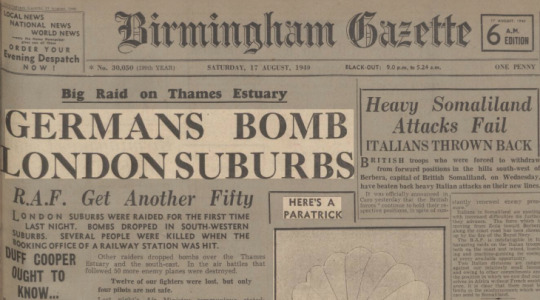
From this website:
"A still earlier, and better recorded, raid took place the night before, on 15 August. 30 bombers targeted RAF Croydon aerodrome, which was then considered part of Surrey rather than London. Several people were killed, with damage to the aerodrome and nearby housing."
The distance between Croydon aerodrome and London is just 10 miles. Again, this is something the impact of which Tom would have very likely heard personally - add to this the feeling of fear and uncertainty over when and where the next attack is coming, and you get a recipe for a serious psychological trauma. Tom was only 13 at this time.
From the same website:
"Many sources state that the first bombs to drop on London landed in the early hours of 22 August 1940, affecting Harrow and Wealdstone (technically not then in London, but within the London Civil Defence Area). These caused damage to two cinemas, a dance hall, bank and houses, but nobody was killed. A further strike on 24 August [in London] killed nine people, and prompted retaliatory attacks on Berlin."
So, by these accounts, Tom experienced the bombing of his city directly at least once and likely heard the impact of bombings from the suburbs at least twice. Could be more - there were several bombings close, and we have no idea where Tom was in those specific moments. He could be taking a walk to the West End, going to the suburbs with his orphanage, and so on.
He was lucky to miss the bombings that followed (until 1944), including the Blitz, but I really hate when people dismiss the psychological impact of seeing your city in ruins, witnessing the massive destruction, and not knowing whether the bombs are going to drop again today. It's not like the Germans announced, "Hey, the Blitz is over, you're safe now!" Of course Tom thought he might experience another bombing, and of course this thought scared him.
The summer of 1944 was terrible for London because that's when the V1 were dropped. Quoting from The Blitz Companion by Mark Clapson again:
"Yet during the summer of 1944 worse was to come, and it would manifest itself in a frightening new weapon. For some months rumours had been circulating in Britain about a flying bomb that had no pilot and which could be guided almost mysteriously through the air at great speed to attack the capital city. This was the V1, the ‘V’ standing for vengeance … The V1s killed over 5,000 people and injured 15,000."
The timeline for these attacks is here.
This one is trickier, though, because based on Harry's era, by 1944, Tom already came of age by wizarding standards. So there is an argument that he could finally use his magic and leave London. On the other hand, he was still a minor by Muggle standards, and we have no idea what Hogwarts rules and laws of his era stated - meaning that it can all be up to interpretation.
For those who prefer to imagine that Tom was there: maybe back in 1944, a wizard had to be 18 to be considered an adult, and the limit was dropped closer to Harry's era. Or there was a rule stating that Hogwarts students must continue to live in their assigned places up until they graduate, especially in a Muggle world - because if a minor disappears from Muggle care when they are still enrolled in a magical school, it could trigger the involvement of authorities, which might be something Hogwarts would want to avoid.
We can't make strong arguments here because the canon says nothing about these details. So, if someone wants to imagine that Tom missed the bombings in 1944, there are very logical reasons to support such a view, but if someone wants him to have experienced it, it's also easy to imagine.
Either way, whether Tom lived only through the bombings of 1940 or both 1940 and 1944, to deny that he was affected by the war is to reject the most basic human psychology, in my opinion. Anyone would be terrified when they are surrounded by destruction and death, when they are confronted with the idea of their own mortality and when they feel helplessly trapped. And Tom saw the war horrors every summer even when there were no bombings.
I'm a war victim myself, and I don't feel safe on the days my city is not attacked. Because I know that the situation can change every other second. The psychological effect of bombings is devastating even when you aren't physically affected.
Does Tom's trauma justify his canon actions in any way, though? Of course not. Did his war trauma cause his fear of death? I think it was definitely at least some part of it. How couldn't it be? It's exactly because he considered himself above others is that his fear could be this amplified. He probably hated sitting stuck in a dangerous zone with the people he despised, threatened by the beings he didn't consider proper humans.
Maybe the war didn't give birth to Tom's fear of death, but I think it obviously contributed to it heavily since, again, he was living in one of the very targeted places, and he lived through at least one London bombing.
Also, yes, I do think Dumbledore and Dippet were absolutely abhorrent for sending an orphan child to a war zone when it was so easy to give him shelter. They were responsible for Tom's well-fare, and this responsibility shouldn't disappear in the summer. Tom could have easily been killed - again, it's not like the Germans announced when they were going to bomb or not bomb London and other areas. Letting him stay at Hogwarts or finding some family to take him in - or an inn! - would have been beyond simple.
Dumbledore also definitely knew Tom is related to a Slytherin bloodline, so there had to be families willing to take him in for this alone. Sure, it could be dangerous in other ways for a child as self-focused as Tom, but he was still a child, and his safety had to come first.
Finally, there is an argument that Tom was moved along with other children from London since it was supposed to be mandatory. This is also something that can be looked at from different angles. The reality of people following a law always differs from the theory of it. There were many issues with evacuations at that time. About 7,736 children died in London from the Blitz alone - not everyone could evacuate, especially the poor. Maybe the Wool's lucked out, maybe not. There are claims that only children within the ages of 5 to 14 were evacuated. But also, if Tom was moved, then there is no telling if he was more or less safe there since the location is unknown. It once again depends on what a specific person wants to imagine as a part of his life.
Now, anon, as for your fics in particular: if you wrote about Tom witnessing the Blitz, it's all right - I mean, the entire universe of Harry Potter is made up. Maybe, in a world where these characters might exist, the Blitz could have happened differently - why not? We have no idea about the dates of HP canon-Blitz. The events there don't have to take place in our specific world.
So, strictly speaking - yes, it's not canon, but more in relation to our world than to the world of HP.
99 notes
·
View notes
Text
Court Circular | 24th January 2024
St James’s Palace
The Princess Royal, Patron, Grand Military Race Committee, today attended the Grand Military Gold Cup Day at Sandown Park Racecourse, Portsmouth Road, Esher, and was received by His Majesty’s Lord-Lieutenant of Surrey (Mr Michael More-Molyneux).
#she was also down to host a reception after the race day at windsor#maybe it was cancelled because of the unpredictable weather???#princess anne#princess royal#court circular
9 notes
·
View notes
Text










July 15th 1964 - John buys Kenwood🌻🌻🌻
Kenwood is a house on the St George's Hill estate, Weybridge, Surrey, England. Originally called the Brown House, it was designed by architect T. A. Allen, and built in 1913 by Love & Sons, a local building firm. The estate was constructed around the Weybridge Golf Club, which was designed in 1912 by Harry Colt. John Lennon, of the Beatles, bought Kenwood for £20,000 (equivalent to £511,900 in 2023) on July 15th 1964, on the advice of the Beatles' accountants, Walter Strach and James Isherwood. Lennon was resident from the summer of 1964 until the late spring of 1968. Film of the gate and the exterior of the house was included in an ITN programme called Reporting 66 in 1966. Parts of a home movie showing Lennon at Kenwood in 1967 were featured in the film Imagine: John Lennon🌻🌸🌻
Kenwood is close to Sunny Heights, the former home of Ringo Starr, and a short drive from Kinfauns, George Harrison's former home in Esher. In October 2006, Kenwood went back on the market at a price of £5.95 million; it was sold in January 2007 for £5.8 million🌸
Via Beatles and Cavern Club Photos FB🌻
#60s icons#girlsofthesixties#60s couples#the beatles wives#john lennon#cynthia lennon#john and cyn#julian lennon#george harrison#pattie boyd#george and pattie#kenwood#1964
26 notes
·
View notes
Photo



From 2016 and 2017 eBay listings, photos of George Harrison and Pattie Boyd at Benclare, the bungalow they rented during their Barbados honeymoon, February 1966, photographer unknown; plus two color photos from their honeymoon, possibly taken by a fan, auctioned by Rago Arts and Auction Center in 2016.
“Pattie Boyd remembers: ‘I was with the Beatles, and all these musicians — and it was a very merry group of people. And I did feel, we are the leaders, the world is ours, and it’ll always be like this. I couldn’t see it crumbling, I couldn’t see it disintegrating. I just thought, this is wonderful! It’s not my parents’ world which is so grey and dull, with no color, no music, not much laughter. I felt at last I’d arrived in the “proper” world.’ [In July 1964, George purchased] a gated bungalow [Kinfauns, see: #harrisonarchivekinfauns] in Esher, Surrey [for himself and Pattie], with a swimming pool and a large garden. But London was near enough for clubs, parties and celebrity screenings. Pattie acquired a white Persian cat called Korky, while George bought an E-type Jaguar and later an Aston Martin DB5. They became vegetarians — but ‘we didn’t eat much…’ Pattie’s favorite was still sweets. The house resonated with the sound of George’s guitar. ‘We were really happy at that time. We were young and creative, and we had lots of friends and musicians who would come over all the time — Mick Jagger for example, and Brian Jones would come quite often, and my brothers and sisters. With George, I could play! I could be a child again. Those were the times I thought would never end.’” - How Was It For You?: Women, Sex, Love and Power in the 1960s by Virginia Nicholson (x)
#George Harrison#Pattie Boyd#George and Pattie#quote#quotes about George#1966#1960s#Harrison fan photos#fits queue like a glove
35 notes
·
View notes
Text
ON THIS DAY - 24 October 1537
On This Day (24 Oct) in 1537, Jane Seymour died at Hampton Court Palace, 12 days after giving birth to her only child, Prince Edward (later Edward VI).
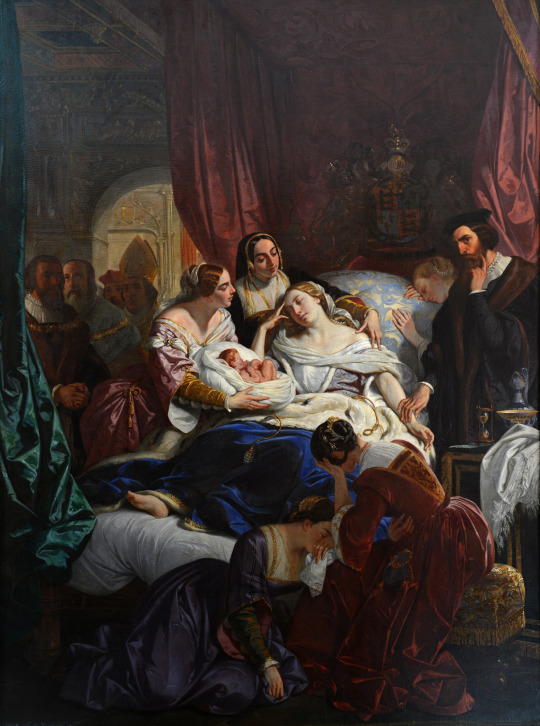
Jane had retreated to Hampton Court from London in mid-September 1537 for her 'lying-in', having escaped from the plague spreading throughout London at that time. Despite no reports of a complicated pregnancy, difficulties began once Jane went into labour on 09 Oct. Her labour was prolonged, lasting approx 30 hours; a solemn procession and prayers were said for her on 11 Oct due to concerns regarding the wellbeing of herself and the child. However, at 2 in the morning, on 12 Oct, Jane delivered a highly-anticipated baby boy, named Edward. Her husband, Henry VIII had been with his own household at nearby Esher Palace, Surrey, and on the news of the birth of his son, rode the 4 miles north directly to Hampton Court.

Edward was christened on 15 Oct in a midnight ceremony at the Chapel Royal at Hampton Court Palace. Due to the risks of plague, attendance at the ceremony was 'limited' to 400 attendees; these included the young prince's godparents Charles Brandon, Duke of Suffolk and the Lady Mary; courtier John Dudley (and likely his wife Jane Guildford), and the prince's uncle Edward Seymour, Viscount Beauchamp, who was known to have carried the young Lady Elizabeth into the chapel. As was tradition, the parents did not attend the ceremony, but rather greeted the guests in the Queen's apartments prior to the procession to the chapel, and then following the completion of the ceremony. Jane participated as expected, with no signs that she was to become so unwell so soon after.

Jane started to become unwell the following afternoon on 16 Oct. She initially suffered from diarrhoea, although stated that she felt better later on. However, during the night her condition worsened, and it became clear that she was suffering from puerperal fever; Alison Weir speculates that it was likely as a consequence of a tear in her perineum during delivery. However, at the time, there were accusations that she had been 'over-indulged' by her attendants, as the understanding of childbirth and hygiene was misunderstood at the time.
Jane's condition worsened so rapidly that she was given last rites by her confessor the Bishop of Carlisle on 17 Oct; however, she appeared to improve, and so celebrations regarding Edward's birth continued. Tragically, Jane quickly became unwell again, entering into a state of delirium, before further deteriorating. On 22 Oct, Thomas Cromwell, Henry's chief minister was informed that she was dying.

At 8pm on 23 Oct, Henry was called to Jane's bedside, and remained with her throughout the night. Last rites were again delivered to her by the Bishop of Carlisle, and she passed away in the early hours of 24 Oct.
Following Jane's death, Henry 'fled' to Windsor Castle, entering into seclusion due to his grief. Thomas Howard, 3rd Duke of Norfolk, was placed in charge of Jane's funeral and burial arrangements. Her body was embalmed on 25 Oct, with her entrails being removed and buried in the Chapel Royal at Hampton Court Palace. Her body was dressed in golden robes, wearing jewels and a crown, and lay in state in the presence chamber at Hampton Court, before being moved to Windsor in Nov, which was to be her final resting place.
Jane's ladies-in-waiting at this time included Mary Brandon, Lady Monteagle (Charles Brandon's daughter from his first marriage, and elder half-sister to Frances Brandon), Anne Parr, Countess of Pembroke (younger sister of Katherine Parr), and Jane Parker, Viscountess Rochford (widow of the ill-fated George Boleyn, who had been executed in May 1536 on charges of high treason), Whilst it is not known if Jane Guilford, Lady Dudley was one of her attendants, Jane is likely to have had a place in the new queen's court, as her husband's status rose. What is known is that she one of the women who accompanied Jane's coffin from Hampton Court to Windsor.
#tudor england#tudor history#tudor people#history#tudor women#tudor#tudors#Jane seymour#Henry viii#Edward vi#childbirth#hampton court palace#Thomas cromwell#windsor castle#jane parker#Jane Guildford#Jane Dudley
4 notes
·
View notes
Text
Wisteria Lodge
Our third story from His Last Bow - we've already done "The Dying Detective" and "The Cardboard Box".
This was published in two parts in The Strand.
Take a note of the Watsonian date here because this will be important later.
A reply-paid telegram was one where the sender also paid for the cost of any reply, up to a certain word limit (48 words for inland telegrams in the 1896 Post Office Guide).
You could send a telegram at most bigger post offices, or you could complete a pre-paid form and put it in a post box.
"Toilet" had a definition of the style of one's appearance.
Eccles is from Lee, which we've visited already in "The Man with The Twisted Lip" and which I discuss in my post for that.
Esher is today a town of around 7,000 people but part of a larger built-up area, thirteen miles from Charing Cross. While sitting outside the Greater London boundary in Surrey, the urban sprawl of London does not match the administrative boundaries and Esher is on the outer edge of this. You can in fact hit some serious countryside while staying within the city limits.
It also sat outside the Metropolitan Police District.
The town was historically a stagecoach stop on the London to Portsmouth road, which later become the A3 before that was diverted via a bypass around the town. It is home to the Sandown Park racecourse and George Harrison lived there for a while.
The railway station, then called Esher and Claremont (the latter being a Lancelot "Capability" Brown-designed mansion, then owned by a widowed daughter-in-law of Queen Victoria, her youngest son Prince Leopold having died due to haemophilia after a fall in 1884) is on the mainline from Waterloo to Weymouth - Aldershot being a bit further along on a branch line. It takes around half an hour to get there by modern electric train; only suburban services stop there, with express trains going straight through the disused centre platforms.
Spain, as a major power (even if most of its empire had already gone) and a monarchy, warranted an Embassy. San Pedro only would have had a legation.
There's quite a bit of racism in this one!
Some pictures of dog-grates can be found here.
Doors on many trains could be opened from the inside at the time, including on the move with the associated risks involved.
War crimes trials were not really a thing at this time.
Yet another case of the villains dying off-page!
The broad plot of this would not be out of place in a modern crime drama.
22 notes
·
View notes
Text
Plantation Shutters and Window Shutters: A Timeless Solution for Modern Homes

In the ever-evolving world of interior design, where trends come and go, certain elements stand the test of time. Among these enduring features are plantation shutters and window shutters, providing a timeless solution for modern homes. These versatile and aesthetically pleasing window coverings not only enhance the visual appeal of a space but also offer numerous practical benefits.
The Timeless Allure of Plantation Shutters
Plantation shutters have a rich history, dating back to the 19th century. Originating in the Southern United States, these shutters were initially designed for plantation homes, offering a balance of light, ventilation, and privacy. Today, their classic design and functionality continue to make them a popular choice for homeowners.
One of the key advantages of plantation shutters in Kingston is their versatility in complementing various architectural styles. Whether your home boasts a contemporary, traditional, or eclectic design, these shutters seamlessly integrate into any setting. The clean lines and adjustable louvers of plantation shutters add a touch of sophistication while allowing homeowners to control natural light and maintain privacy.
Elegance and Functionality in Window Shutters
Window shutters, a broader category that includes plantation shutters, provide an elegant and functional solution for window coverings. Unlike traditional curtains or blinds, shutters offer a unique combination of aesthetic appeal and practical benefits. With their ability to regulate sunlight, provide insulation, and enhance the overall atmosphere of a room, window shutters have become a staple in modern home design.
The timeless appeal of window shutters is evident in their ability to stand out or blend in seamlessly, depending on the desired effect. They contribute to the overall aesthetics of a home, creating a polished and cohesive look. Additionally, window shutters are available in various materials, allowing homeowners to choose options that match their preferences and the existing décor of their homes.
Why Choose Plantation Shutters in Kingston
If you're contemplating window coverings for your home, the choice of plantation shutters in Kingston becomes even more appealing. The picturesque town of Kingston, with its blend of historical charm and contemporary living, provides a perfect backdrop for these timeless window treatments.
The article at theshutterworks.co.uk delves into the specific reasons why plantation shutters are an excellent choice for Kingston residents. From enhancing the architectural aesthetics of historical homes to seamlessly integrating with modern interiors, these shutters cater to a diverse range of preferences.
Benefits Beyond Aesthetics
While the visual appeal of plantation shutters is undeniable, their benefits extend beyond aesthetics. The adjustable louvers allow homeowners to control the amount of natural light entering a room, providing flexibility throughout the day. Moreover, the insulation properties of plantation shutters contribute to energy efficiency, keeping homes cooler in summer and warmer in winter.
In Kingston's unique setting, where historical charm meets contemporary living, plantation shutters offer a practical and visually pleasing solution. Whether you're renovating a period property or adding a touch of timeless elegance to a modern home, these shutters prove to be a valuable investment. In conclusion, the enduring charm of plantation shutters and window shutters in Kingston makes them a timeless solution for modern homes. Their ability to blend seamlessly with various design styles, coupled with practical benefits, ensures their continued popularity in the ever-changing landscape of interior design. For Kingston residents, the choice of plantation shutters becomes even more compelling, adding a touch of sophistication to homes in this picturesque town.
#plantation shutters kingston#window shutters kingston#Surbiton#Kingston#Wimbledon#Teddington#Esher#Kingston upon Thames#Twickenham#Surrey
0 notes
Text

Stylish Plantation Shutters in Surrey
At Bright Light Shutters, you can find high-quality plantation shutters in Surrey, all at exceptionally affordable prices.
We serve our clients in Chessington, Kingston, Twickenham, Leatherhead, Surbiton, Guildford, Farnham, Esher, Epsom, New Malden, Worcester Park, Teddington and across Surrey and South West London. To learn more about our services, visit our website.
#plantation shutters surrey#plantation shutters#Chessington#Kingston#wickenham#Leatherhead#Surbiton#Guildford#Farnham#Esher#Epsom#New Malden#Worcester Park#Teddington#Surrey#South West London
0 notes
Text
A Fish Called Wanda plotholes...
Yup, PLOTHOLES, fellows, plotholes.


Wanda and Otto drive to Archie in the light of day. We can see it's summer, and the light looks like it's early evening, so it's presumeably not later than 6 p.m. in the evening.

Portia and Wendy also leave in the light of day for the opera. Operas usually take about 2 hours including a 30 minute break which means it's likely to start at 7:30 p.m. and finish at 10 p.m..
Let's just say, for argument's sake, that they go to the Royal Opera ; this is their route according to google maps:

As you can see it takes them about 1:15 h to get from Esher, Surrey to the opera, depending on the traffic. So if Wendy plans + 15 extraminutes for the traffic to be at opera around 7:15 p.m. she and Portia are leaving around 5:45 p.m..
5:45 p.m. + 1:15 h driving time + 15 extraminutes = 7:15 p.m..
And it makes sense when you look at the lighting of the scene and the daylight.

When their car breakes down it happens in the light of day. And as far as I'm concerned, they can't have gotten very far, so presumeably they're still in Esher.

Wanda and Otto are already in Esher as we can see when they come accross Wendy and Portia.

In the meantime it gets dark so Archie switches the lights on...

BUT when Wanda and Otto break into Archie's house, it's dark all of a sudden??
Remember: it's summer here, so it won't get dark until 9, 9:30 p.m.!
That leaves me with 2 questions:
- Did Wanda and Otto wait until it gets dark before they break in?
- If so, what the hell did they do until it got dark?
It would make sense for Wanda and Otto to wait until it's dark though but that would lead us back to question 2.
#a fish called wanda#wendy leach#maria aitken#archie leach#john cleese#wanda gershwitz#jamie lee curtis#plot holes
5 notes
·
View notes
Text
Happy Birthday 🎂 🥳 🎉 🎈 🎁 🎊 To You
The Young English 🇬🇧 Lily 💮 Actress Of Beautiful & Dazzling Acting In Cinema 🎥 Today
Lily Chloe Ninette Thomson was born on 5 April 1989 in Esher, Surrey, the daughter of Ninette Mantle, an actress, and James "Jamie" Thomson, a musician. She has two brothers, one older and one younger. Her paternal grandmother, Helen Horton, was an American actress.
better known by her stage name Lily James, is an English actress. She studied acting at the��Guildhall School of Music and Drama in London and began her career in the British television series Just William (2010). Following a supporting role in the period drama series Downton Abbey (2012–2015), her breakthrough was the title role in the fantasy film Cinderella (2015).
James went on to portray Natasha Rostova in the television adaptation of War & Peace (2016) and starred in several films, including the action film Baby Driver (2017), the period dramas Darkest Hour (2017), The Guernsey Literary and Potato Peel Pie Society (2018) and The Dig (2021), and the musicals Mamma Mia! Here We Go Again (2018) and Yesterday (2019). Her portrayal of Pamela Anderson in the biographical series Pam & Tommy (2022) earned her nominations for a Golden Globe and a Primetime Emmy Award.
Please Wish This Young & Delightful English Lily 💮Actress Of Beautiful Cinema 🎥 A Very Happy Birthday 🎂 🥳 🎉 🎈 🎁 🎊
Ms. Lily 💮James 🇬🇧
Happy 35th Birthday 🎂 🥳 🎉 🎈 🎁 🎊 To You Ms. James💮🇬🇧 & Heres To Many More Years To Come





#LilyJames
2 notes
·
View notes
Text



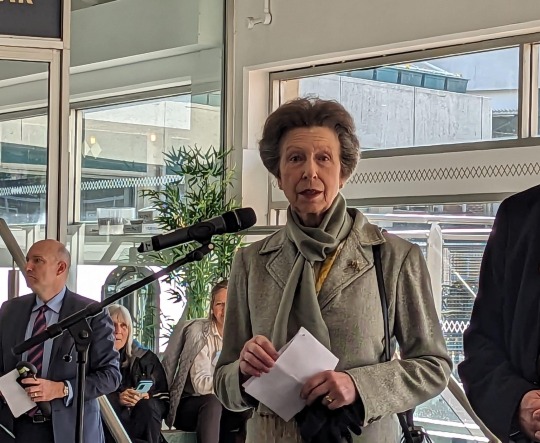
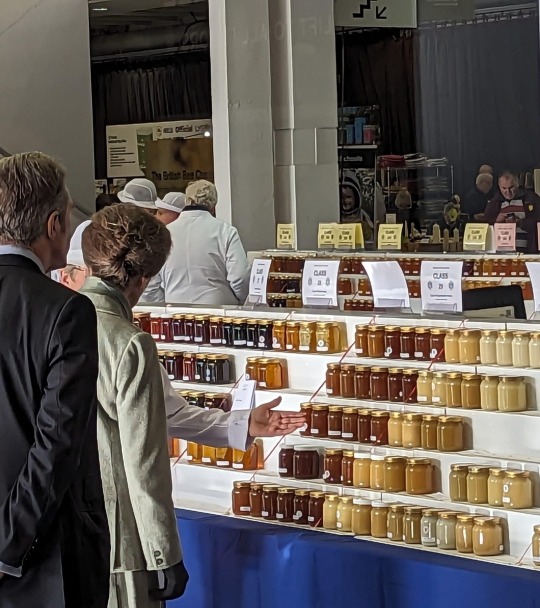
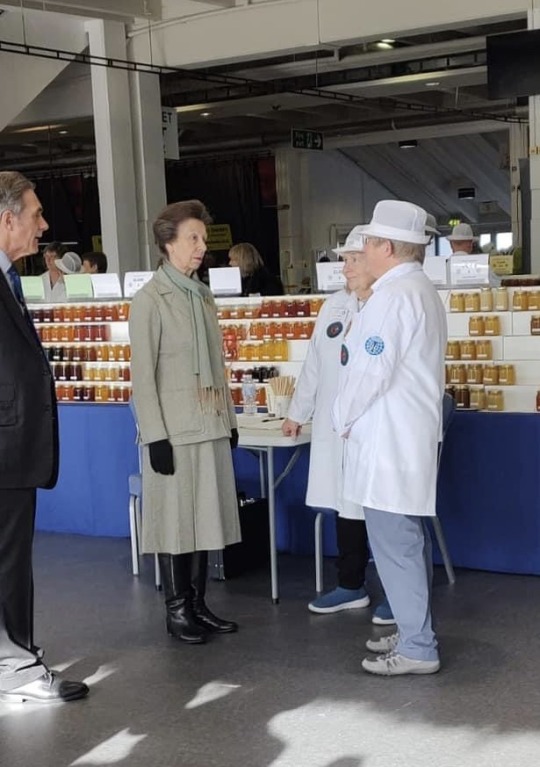
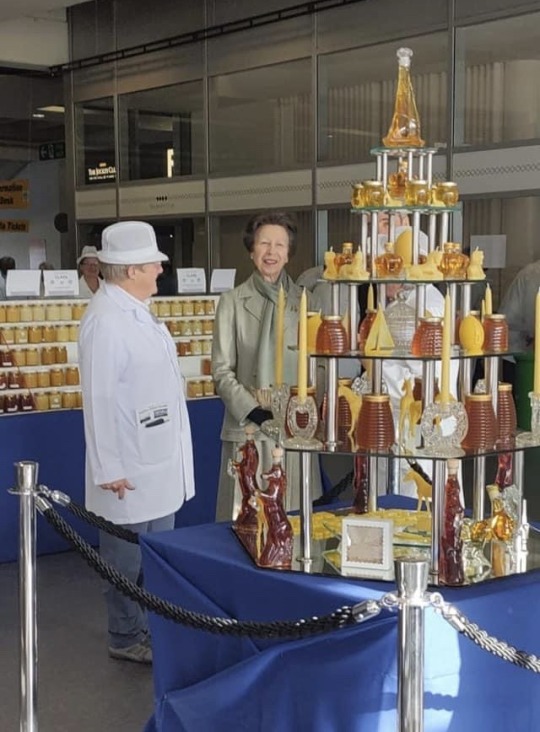
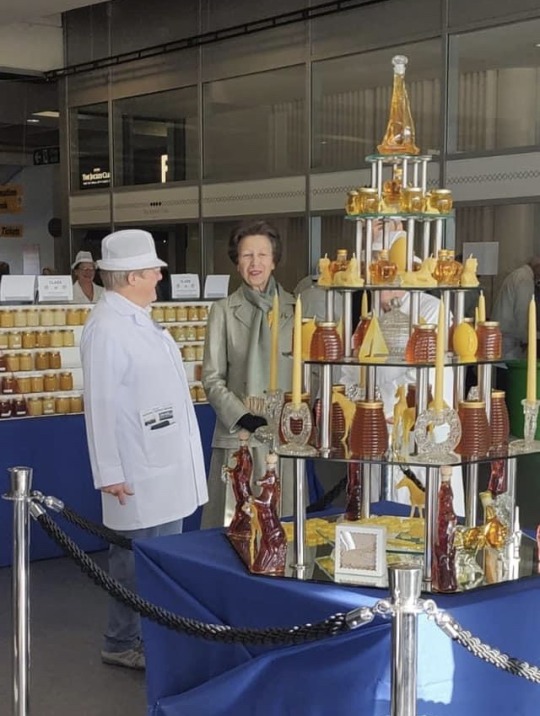
🍯 🐝
Princess Anne at the National Honey Show at Sandown Park Racecourse in Esher, Surrey on 26th October 2023.
58 notes
·
View notes